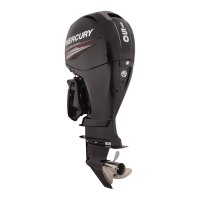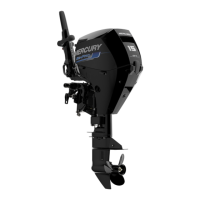GENERAL INFORMATION
Page 1C-4 90-826883R2 JUNE 1998
CAVITATION
Cavitation is caused by water vapor bubbles forming either from a sharp edge or angle
on the gear case or from an irregularity in the propeller blade itself. These vapor bubbles
flow back and collapse when striking the surface of the propeller blade resulting in the ero-
sion of the propeller blade surface. If allowed to continue, eventual blade failure (break-
age) will occur.
Engine
DETONATION
Detonation in a 2-cycle engine resembles the “pinging” heard in an automobile engine.
It can be otherwise described as a tin-like “rattling” or “plinking” sound.
Detonation is an explosion of an unburned portion of the fuel/air charge after the spark
plug has fired. Detonation creates severe shock waves in the engine, and these shock
waves often find or create a weakness: The dome of a piston, cylinder head/gasket, piston
rings or piston ring lands, piston pin and roller bearings.
A few of the most common causes of detonation in a marine 2-cycle application are as
follows:
• Over-advanced ignition timing.
• Use of low octane gasoline.
• Propeller pitch too high (engine RPM below recommended maximum range).
• Lean fuel mixture at or near wide-open-throttle.
• Spark plugs (heat range too hot - incorrect reach - cross-firing).
• Inadequate engine cooling (deteriorated cooling system).
• Combustion chamber/piston deposits (result in higher compression ratio).
Detonation usually can be prevented if:
1. The engine is correctly set up.
2. Diligent maintenance is applied to combat the detonation causes.
51115
Damaged Piston Resulting from Detonation

